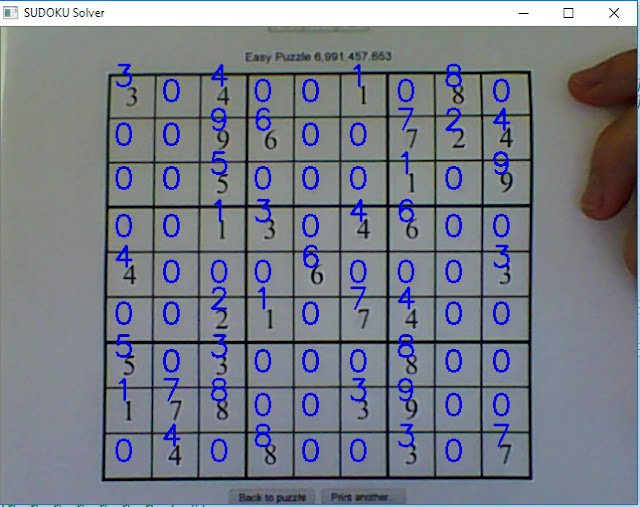Building a simple SUDOKU Solver from scratch - Part 2: Digit Number Recognition using SVM
In this post, we will continue the previous tutorial on recognizing digital number were extracted from SUDOKU board. See part 1
In part 1 of this series, we learned how to detect lines and extract the digit numbers from the SUDOKU board. It’s easy to extract digit numbers and save it as images (Uncomment the code from Part 1 to save your own digit blocks). Now, let’s talk about training those extracted digital numbers with SVM
With the code from Part 1, we can easily save more than 1,000 digit images within a second.

Fig. 1. The extracted digit images
To train the dataset with a supervised machine learning method like SVM, we need to label the dataset beforehand. With this dataset, we have 10 labels (from 0 -> 9). So, the idea is that we will create 10 folders with the name from 0 to 9 and put those images into the corresponding folder.
It’s time-consuming because we have a lot of images :(
Don’t worry! I already created a labeled dataset for you. Check out my GitHub repository to download the dataset: https://github.com/huuquan1994/Sudoku-Solver
I divided it into 2 parts, training set, and testing set. 5000 images in the training set (500 images in each folder) and ~3000 test images in the testing set.

Fig. 2. We need to create 10 folders to store the images

Fig. 3. Folder with the images labeled "1"
We have all we need! Now, let’s train SVM to recognize digital number.
We will use LinearSVM in Sklearn to train the dataset, using joblib to save the SVM model after training.
For training, first, we resize the size of each training image to \(36\times36\). After that, we train those resized images with LinearSVM. You can see the code below
import numpy as np from sklearn.svm import LinearSVC import os import cv2 import joblib # Generate training set TRAIN_PATH = "Dataset\Train" list_folder = os.listdir(TRAIN_PATH) trainset = [] for folder in list_folder: flist = os.listdir(os.path.join(TRAIN_PATH, folder)) for f in flist: im = cv2.imread(os.path.join(TRAIN_PATH, folder, f)) im = cv2.cvtColor(im, cv2.COLOR_RGB2GRAY ) im = cv2.resize(im, (36,36)) trainset.append(im) # Labeling for trainset train_label = [] for i in range(0,10): temp = 500*[i] train_label += temp # Generate testing set TEST_PATH = "Dataset\Test" list_folder = os.listdir(TEST_PATH) testset = [] test_label = [] for folder in list_folder: flist = os.listdir(os.path.join(TEST_PATH, folder)) for f in flist: im = cv2.imread(os.path.join(TEST_PATH, folder, f)) im = cv2.cvtColor(im, cv2.COLOR_RGB2GRAY ) im = cv2.resize(im, (36,36)) testset.append(im) test_label.append(int(folder)) trainset = np.reshape(trainset, (5000, -1)) # Create an linear SVM object clf = LinearSVC() # Perform the training clf.fit(trainset, train_label) print("Training finished successfully") # Testing testset = np.reshape(testset, (len(testset), -1)) y = clf.predict(testset) print("Testing accuracy: " + str(clf.score(testset, test_label))) joblib.dump(clf, "classifier.pkl", compress=3)
After training, we will have an SVM model named: classifier.pkl.
We can use this file to recognize block images.

Fig. 4. Result of recoginited digits from SVM
See this code for more details:
import cv2 import numpy as np import joblib font = cv2.FONT_HERSHEY_SIMPLEX ratio2 = 3 kernel_size = 3 lowThreshold = 30 clf = joblib.load('classifier.pkl') is_print = True cv2.namedWindow("SUDOKU Solver") vc = cv2.VideoCapture(0) if vc.isOpened(): # try to get the first frame rval, frame = vc.read() else: rval = False while rval: sudoku1 = cv2.cvtColor(frame, cv2.COLOR_BGR2GRAY) sudoku1 = cv2.blur(sudoku1, (1,1)) edges = cv2.Canny(sudoku1, lowThreshold, lowThreshold*ratio2, kernel_size) lines = cv2.HoughLines(edges, 2, cv2.cv.CV_PI /180, 300, 0, 0) if (lines is not None): lines = lines[0] lines = sorted(lines, key=lambda line:line[0]) diff_ngang = 0 diff_doc = 0 lines_1=[] Points=[] for rho,theta in lines: a = np.cos(theta) b = np.sin(theta) x0 = a*rho y0 = b*rho x1 = int(x0 + 1000*(-b)) y1 = int(y0 + 1000*(a)) x2 = int(x0 - 1000*(-b)) y2 = int(y0 - 1000*(a)) if (b>0.5): if(rho-diff_ngang>10): diff_ngang=rho lines_1.append([rho,theta, 0]) else: if(rho-diff_doc>10): diff_doc=rho lines_1.append([rho,theta, 1]) for i in range(len(lines_1)): if(lines_1[i][2] == 0): for j in range(len(lines_1)): if (lines_1[j][2]==1): theta1=lines_1[i][1] theta2=lines_1[j][1] p1=lines_1[i][0] p2=lines_1[j][0] xy = np.array([[np.cos(theta1), np.sin(theta1)], [np.cos(theta2), np.sin(theta2)]]) p = np.array([p1,p2]) res = np.linalg.solve(xy, p) Points.append(res) if(len(Points)==100): sudoku1 = cv2.adaptiveThreshold(sudoku1, 255, cv2.ADAPTIVE_THRESH_GAUSSIAN_C,cv2.THRESH_BINARY_INV, 101, 1) for i in range(0,9): for j in range(0,9): y1=int(Points[j+i*10][1]+5) y2=int(Points[j+i*10+11][1]-5) x1=int(Points[j+i*10][0]+5) x2=int(Points[j+i*10+11][0]-5) X = sudoku1[y1:y2,x1:x2] if(X.size!=0): X = cv2.resize(X, (36,36)) num = clf.predict(np.reshape(X, (1,-1))) if (num[0] != 0): cv2.putText(frame,str(num[0]),(int(Points[j+i*10+10][0]+10), int(Points[j+i*10+10][1]-30)),font,1,(225,0,0),2) else: cv2.putText(frame,str(num[0]),(int(Points[j+i*10+10][0]+10), int(Points[j+i*10+10][1]-15)),font,1,(225,0,0),2) cv2.imshow("SUDOKU Solver", frame) rval, frame = vc.read() key = cv2.waitKey(20) if key == 27: # exit on ESC break vc.release() cv2.destroyAllWindows()
Oh Yeahhhh! Now we know how to train a machine learning method and recognize a digital image. The next article, we will discuss how to solve a SUDOKU matrix by backtracking algorithm.
If you have any questions or comments, please let me know. See ya :)
